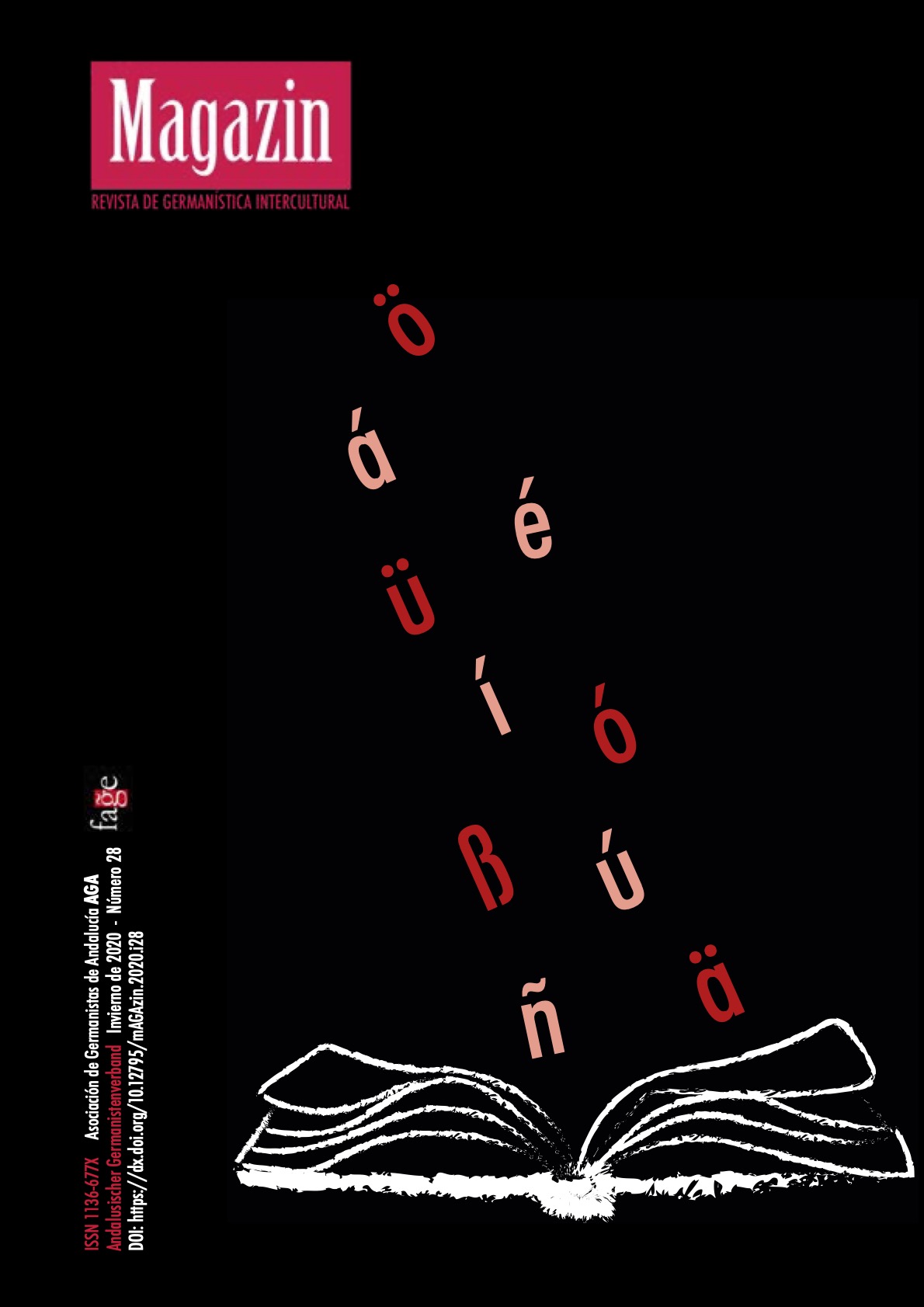The Translation of Fictional Worlds in Literature between German and Spanish: The Case of Die andere Seite. Ein phantastischer Roman by Alfred Kubin
DOI:
https://doi.org/10.12795/mAGAzin.2020.i28.06Keywords:
fictional worlds, German, Kubin, literary translation, SpanishAbstract
This paper is centered on the research of the translation
of the narrative structures called «fictional worlds» in
the literary modality between German and Spanish.
Specifically, the mechanisms that can be implemented
to the transfer of the concrete elements that act as the
foundations of fictional worlds between sociocultural
contexts will be analyzed in it. The functional rendering of
these components guarantees that the target recipients
will be able to mentally conceive the new narrative
reality and this is why it is fundamental to undertake
this task efficiently. This paper’s research goals will
be accomplished by means of the observation of the
fictional world built in the work Die andere Seite. Ein
phantastischer Roman by Alfred Kubin, which presents
an outstanding example of this type of hypothetical
dimensions. This analysis is based on theories pertaining
to the field of Descriptive Translation Studies and on
the works by authors such as Toury (1980), Lambert
and Van Gorp (1985) or Munday (2001). It consists on
the integral search of the founding conceptual elements
of the universe of this novel, a selection of the most
relevant examples for the objectives of this paper and its
translation dissection in order to identify the processes
used to render them and to assess the functionality of
each of the equivalents proposed to evoke the reality
shown in this novel in the Spanish-speaking context.
Downloads
References
Andrade, P., Gimber, A. y Goicoechea, M. (2010). Espacios y tiempos de lo fantástico. Peter Lang. https://doi.org/10.3726/978-3-0351-0057-0
Bassnett, Susan (2002). Translation Studies. Routledge. https://doi.org/10.4324/9780203427460
Centro Virtual Cervantes (5 de noviembre de 2020). Martes neológico. https://blogscvc.cervantes.es/martes-neologico/glosario/
Chilvers, I. (2007). Diccionario de arte. (Trads. A. Adell y B. Moreno Carrillo). Alianza Editorial.
Doležel, L. (1998). Heterocósmica: ficción y mundos posibles. Arco/Libros.
Filoramo, G. (2001). Diccionario Akal de las Religiones. Akal.
Fundéu BBVA (5 de noviembre de 2020). Consultas. https://www.fundeu.es
Gavins, J. y Lahey, E. (2016). World Building: Discourse of the Mind. Bloomsbury. http://dx.doi.org/10.5040/9781474295444.ch-001
Hayes, J. A. (1975). The Translator and the Form-Content Dilemma in Literary Translation. Modern Languages, 90(6), 838-848. https://doi.org/10.2307/2907023
Hermans, T. (ed.) (2014). The Manipulation of Literature. Studies in Literary Translation. Croom Helm. https://doi.org/10.4324/9781315759029
Illig, C., Grossman, R. y Slabý, R. (2002). Diccionario de las lenguas española y alemana, Tomo II: Alemán-Español. Herder.
Kubin, A. (1988). La otra parte: una novela fantástica (Trad. J. J. Del Solar). Siruela
Kubin, A. (2017). The Life and Art of Alfred Kubin. Courier Dover Publications.
Kubin, A.(2019). Die andere Seite. Ein phantastischer Roman. Rowohlt Taschenbuch Verlag.
Lambert, J. y Van Gorp, H. (1985). On Describing Translations. En T. Hermans (Ed.), The Manipulation of Literature. Studies in Literary Translation (42-53). Croom Helm.
Lefevere, A. (1992). Traducción, reescritura y la manipulación del canon literario (Trads. C. Á. Vidal y R. Álvarez). Colegio de España.
Machin, D. (2014). Visual Communication. Walter de Gruyter GmbH & Co KG. https://doi.org/10.1515/9783110255492
McColl, R. W. (2014). Encyclopedia of World Geography. Infobase Publishing.
Mestica, G. S. (1998). Diccionario Akal de Mitología. Akal.
Miller, D. G. (2004). English Lexicogenesis. Oxford University Press.
Munat, J. (2015). Lexical Creativity. En R. H. Jones (Ed.), Routledge Handbook of Language and Creativity (92-106). Routledge.
Munday, J. (2016). Introducing Translation Studies. Theories and Applications. Routledge. https://doi.org/10.4324/9781315691862
Nord, C. (2018). Translating as a Purposeful Activity: Functionalist Approaches Explained. Routledge. https://doi.org/10.4324/9781351189354
Pandley, B. D. (2014). Zoology at a Glance. Scientific Publishers.
Pikabea Torrano, I. (2008). Glosario del lenguaje. Netibiblio.
Prince, G. (2003). A Dictionary of Narratology. Nebraska University Press. https://doi.org/10.1093/fmls/cqi055
Quintana, J. C. y López Aguilar, F. (2007). Interacción electromagnética: teoría clásica. Reverté.
Real Academia Española (4 de noviembre de 2020). Diccionario Panhispánico de Dudas. http://rae.es/dpd/
Real Academia Española (4 de noviembre de 2020). Diccionario de la Lengua Española. http://rae.es/recursos/diccionarios/drae
Real Academia Española y Asociación de Academias de la Lengua Española (2010). Ortografía de la lengua española. Espasa.
Reimann, M. (1999). Gramática esencial del alemán (Spanische Version). Max Hueber Verlag.
Ronen, R. (1994). Possible Worlds in Literary Theory. Cambridge University Press.
Ryan, M. L. (1980). Fiction, Non-factuals and the Principle of Minimal Departure. Poetics, 9(4), 403-422. https://doi.org/10.1016/0304-422X(80)90030-3
Ryan, M. L. (1991). Possible Worlds, Artificial Intelligence and Narrative Theory. Indiana
University Press.
Stenhoff, M. (2006). Ball Lightning: An Unsolved Problem in Atmospheric Physics. Springer.
Szymyślik, R. P. (2019). Estudio de los problemas de traducción vinculados a mundos ficticios: Fahrenheit 451 de Ray Bradbury [Tesis Doctoral, Universidad
Pablo de Olavide (Sevilla)].
Toury, G. (1980). In Search of a Theory of Translation. Porter Institute for Poetics.
Toury, G. (1995). Los estudios descriptivos de traducción y más allá. Metodología de la investigación en Estudios de Traducción (Trads. R. Merino Álvarez y R. Rabadán). Cátedra.
UNESCO (5 de noviembre de 2020). Index Translationum. https://bit.ly/3r35ETp
Valero Garcés, C. (2007).Modelo de evaluación de obras literarias traducidas. Peter Lang.
Wahrig-Burfeind, R. (2012). Wahrig: Wörterbuch der deutschen Sprache. Dt. Taschenbuch-Verlag.
Wellek, R. y Warren, A. (1979). Teoría literaria (Trad. J. M. Gimeno). Gredos.
Published
How to Cite
Issue
Section
License
Self-archiving policy
Romeo Blue Journal (applied)
Only editor PDF can be archived
Author cannot archive the pre-print version
Author cannot archive the postprint version




